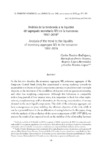Análisis de la tendencia a la liquidez del agregado monetario M3 en la eurozona: 1997-2018

Use this link to cite
http://hdl.handle.net/2183/24755
Except where otherwise noted, this item's license is described as Atribución-NoComercial-SinDerivadas 4.0 Internacional
Collections
- Investigación (FEE) [923]
Metadata
Show full item recordTitle
Análisis de la tendencia a la liquidez del agregado monetario M3 en la eurozona: 1997-2018Alternative Title(s)
Analysis of the Trend to the Liquidity of Monetary Aggregate M3 in the Eurozone: 1997-2018Author(s)
Date
2020Citation
Pateiro-Rodriguez, C., Freire-Seoane, M.J., Lopez-Bermudez, M.B. y Pateiro-Lopez, C. (2020). Análisis de la tendencia a la liquidez del agregado monetario M3 en la eurozona: 1997-2018. Trimestre económico, 87(345), 171-201. https://doi.org/10.20430/ete.v87i345.956
Abstract
[Abstract] In the last two decades, the monetary aggregate M3, reference aggregate of the
Eurpoean Central Bank (ecb), has experienced a strong tendency towards its
accumulation in the most liquid components: currency in circulation and overnight
deposits, to the detriment of the modalities of deposits with an agreement maturity,
and other less weighting components. Although this behaviour is compatible
with a long period of low interest rates, it is important to look for other explanations,
complementary and/or alternative, to the strong concentration of money
demand in the most liquid components. This drift of the reference aggregate can
have consequences on price stability, the ultimate objective of the ecb, while it
can be a potential factor in the modification of saving behavior. In this paper, along
with the analysis of the evolution of the seven components of M3 1997-2018, we
present the results of an empirical work on the stability of the relationship between the demand for money and the macroeconomic variables that determine it. The
results show that the strong financial disturbances and uncertainties as a result
of the crisis, as well as the unconventional decisions on monetary policy adopted
by the ecb have some explanatory capacity of the studied phenomenon. [Resumen] Durante las dos últimas décadas, el agregado monetario M3, de referencia del Banco
Central Europeo (bce), ha experimentado una fuerte tendencia hacia su acumulación
en los componentes más líquidos: efectivo en circulación y depósitos a la
vista, en detrimento de las modalidades de depósitos a plazo y otros componentes
de menor ponderación. Si bien este comportamiento es compatible con una larga
etapa de bajas tasas de interés, resulta interesante la búsqueda de otras explicaciones,
complementarias y/o alternativas, a la fuerte concentración de la demanda
de dinero en los activos más líquidos. Esta deriva del agregado de referencia puede
tener consecuencias sobre la estabilidad de precios, objetivo último del bce, al
mismo tiempo que puede constituirse en un elemento potencial de la modificación
del comportamiento del ahorro. En este trabajo, junto con el análisis de la evolución
de los siete componentes del M3 1997-2018, presentamos los resultados de
un trabajo empírico sobre la estabilidad de la relación entre la demanda de dinero
y las variables macroeconómicas determinantes. Los resultados muestran que las
fuertes perturbaciones e incertidumbres financieras a raíz de la crisis, así como
las decisiones de política monetaria no convencional (quantitative easing) adoptadas
por el bce poseen alguna capacidad explicativa del fenómeno estudiado.
Keywords
Monetary policy
Monetary aggregate
Liquidity
Unit root
Stability
Política monetaria
Agregado monetario
Raíces unitarias
Liquidez
Estabilidad
Monetary aggregate
Liquidity
Unit root
Stability
Política monetaria
Agregado monetario
Raíces unitarias
Liquidez
Estabilidad
Editor version
Rights
Atribución-NoComercial-SinDerivadas 4.0 Internacional
ISSN
2448-718X






